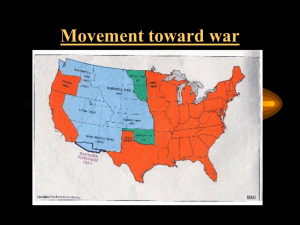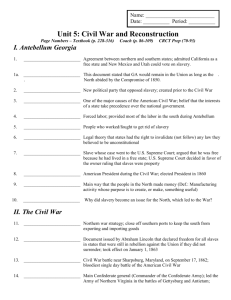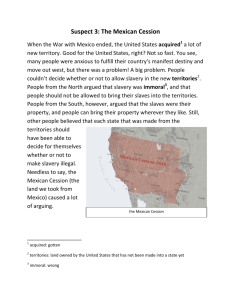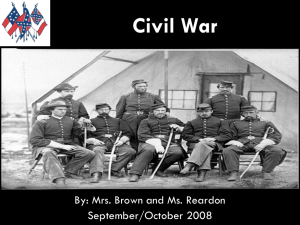Eli Whitney
advertisement
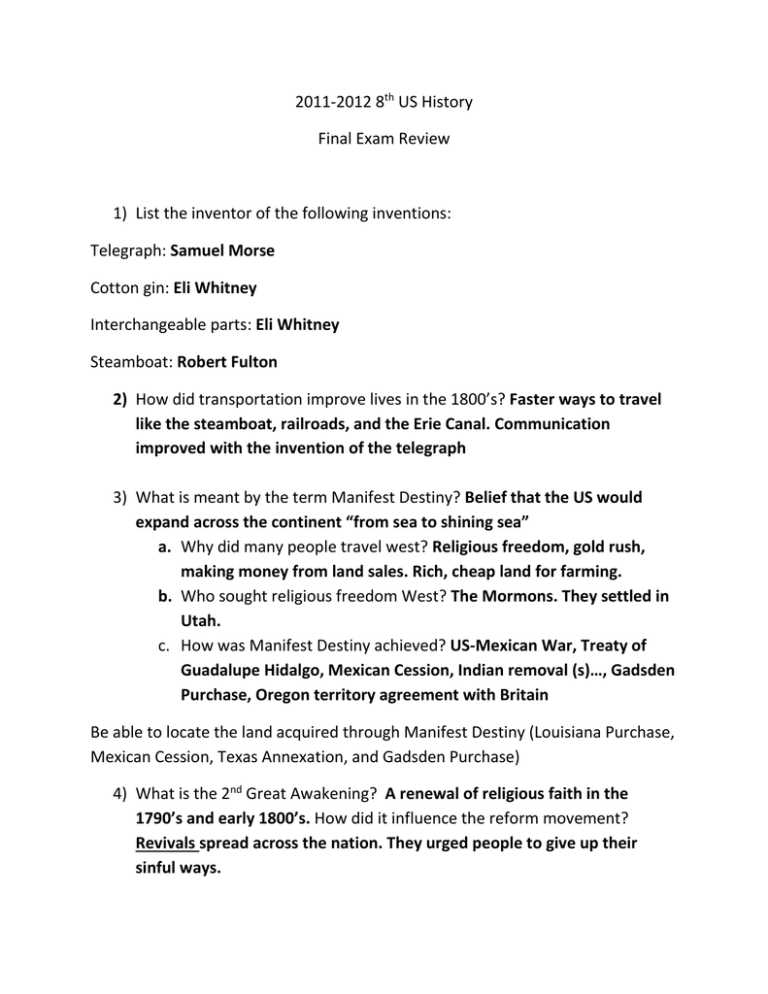
2011-2012 8th US History Final Exam Review 1) List the inventor of the following inventions: Telegraph: Samuel Morse Cotton gin: Eli Whitney Interchangeable parts: Eli Whitney Steamboat: Robert Fulton 2) How did transportation improve lives in the 1800’s? Faster ways to travel like the steamboat, railroads, and the Erie Canal. Communication improved with the invention of the telegraph 3) What is meant by the term Manifest Destiny? Belief that the US would expand across the continent “from sea to shining sea” a. Why did many people travel west? Religious freedom, gold rush, making money from land sales. Rich, cheap land for farming. b. Who sought religious freedom West? The Mormons. They settled in Utah. c. How was Manifest Destiny achieved? US-Mexican War, Treaty of Guadalupe Hidalgo, Mexican Cession, Indian removal (s)…, Gadsden Purchase, Oregon territory agreement with Britain Be able to locate the land acquired through Manifest Destiny (Louisiana Purchase, Mexican Cession, Texas Annexation, and Gadsden Purchase) 4) What is the 2nd Great Awakening? A renewal of religious faith in the 1790’s and early 1800’s. How did it influence the reform movement? Revivals spread across the nation. They urged people to give up their sinful ways. 5) What contribution did Dorothea Dix make? Reform of treatment for the mentally ill. Have separate facilities for mentally ill patients instead of sending them to prison. 6) Describe the term civil disobedience. A form of peaceful protest in which people refuse to obey laws they consider to be unjust. Who is considered to be the leader of civil disobedience in the 1800’s? Henry David Thoreau 7) Summarize the Monroe Doctrine. Warned European nations not to interfere with Latin & South America. 8) Andrew Jackson had many significant issues occur during his presidency. Explain the issues listed below: a. Spoils system: The practice of giving government jobs to political supporters b. Bank wars: AJ said that the bank was unconstitutional. AJ did not renew the Bank’s charter. c. Trail of Tears: The route that Cherokees were forced to travel from Georgia to Indian Territory. d. Nullification crisis: John C. Calhoun believed that Congress had no right to impose a tariff that favored one section of the country. JCC said that South Carolina had the right nullify the “Tariff of Abominations” 9) Why was the tariff of abominations hated by the South? Southerners had to sell their cotton at lower prices to be competitive. Southerners also had to pay high prices for manufactured goods that they needed. 10) Explain the significance of the following compromises: a. Missouri compromise: settled the balance of free vs. slave states b. Compromise of 1850: tried to settle the issue of slavery when California was admitted as a free state c. Kansas/Nebraska Act: allowed people to vote on whether they would allow slavery or not. 11) What were the long term causes of the war? (4 s’s) Slavery, Sectionalism, Secession, State’s Rights 12) What advantages did the North have before the Civil War? More people, manufacturing capabilities, better communication (more miles of telegraph lines), more miles of rail lines, more money 13) What advantages did the South have? Stronger reason to fight, better military leadership, fighting on home turf 14) What was the significance of the Dred Scott case? Supreme Court case that said slaves were property not citizens, also said that the westward expansion of slavery was legal. 15) Explain the importance of the following battles: a. Fort Sumter: 1st battle of the Civil War b. Antietam: Bloodiest single day in American History c. Vicksburg: Gave Union control of the Mississippi; split the south in half. d. Gettysburg: turning point of the CW in favor of the Union. e. Appomattox Courthouse: where Lee surrendered to Grant. 16) Explain the Emancipation Proclamation. Legally freed all slaves on rebelling southern states. Why did Lincoln issue it? The end of slave labor would weaken the South’s war effort. What were the results? Actually freed very few slaves. 17) How did women contribute during the Civil War? Plowed fields and ran plantations. Took jobs in offices and factories. They also served as nurses. 18) How did Lincoln feel the South should be treated after the Civil War? With malice towards none… How did that differ from the Radical Republicans? The RR’s felt that Lincoln would not punish the south enough. 19) What does the concept of “total War” mean? EVERYTHING that was in the path of the Union would be destroyed. Who directed the “total War” campaign for the Union? Grant & Sherman ( Sherman’s march to the sea). 20) Explain the impact of the following Reconstruction amendments: a. 13th amendment: Officially ended slavery; made it illegal. “FREE” b. 14th amendment: Granted rights of citizenship to all slaves. “CITIZENS” c. 15th amendment: Gave the right to vote to former MALE slaves. “VOTE” 21) What are the black codes? They were designed to suppress the rights of the newly freed slaves. 22) a. b. c. d. e. f. g. h. i. 23) a. b. c. d. e. f. g. Explain the contributions of the following people: Frederick Douglass: Escaped slavery. Wrote his autobiography that showed the horrors of slavery. Harriet Beecher Stowe: wrote Uncle Tom’s Cabin. Showed the horrors of slavery Harriet Tubman: Conductor of the Underground railroad Jefferson Davis: President of the Confederate States during the CW. Robert E. Lee: Supreme Commander of the Confederate Army Ulysses S. Grant: Commander of the Union forces after Gettysburg. John Brown: radical abolitionist. Involved in Bleeding Kansas as well as the raid on Harper’s Ferry. Abraham Lincoln: President of the Union during the CW. Elizabeth Cady Stanton: organizer of Seneca Falls convention; fought for the women’s rights. Know the following vocabulary terms: Secession: The withdrawal of states from the Union. Ironclads: The Monitor & The Merrimack. Some of the first examples of armor plating on warships. Freedman’s bureau: organization that helped former slaves Abolition: the movement to end slavery Temperance: the movement to end the consumption of alcohol Sectionalism: preference for one’s own section of the country as opposed to the nation as a whole. Reconstruction: The process by which Confederate states were admitted back into the Union.
